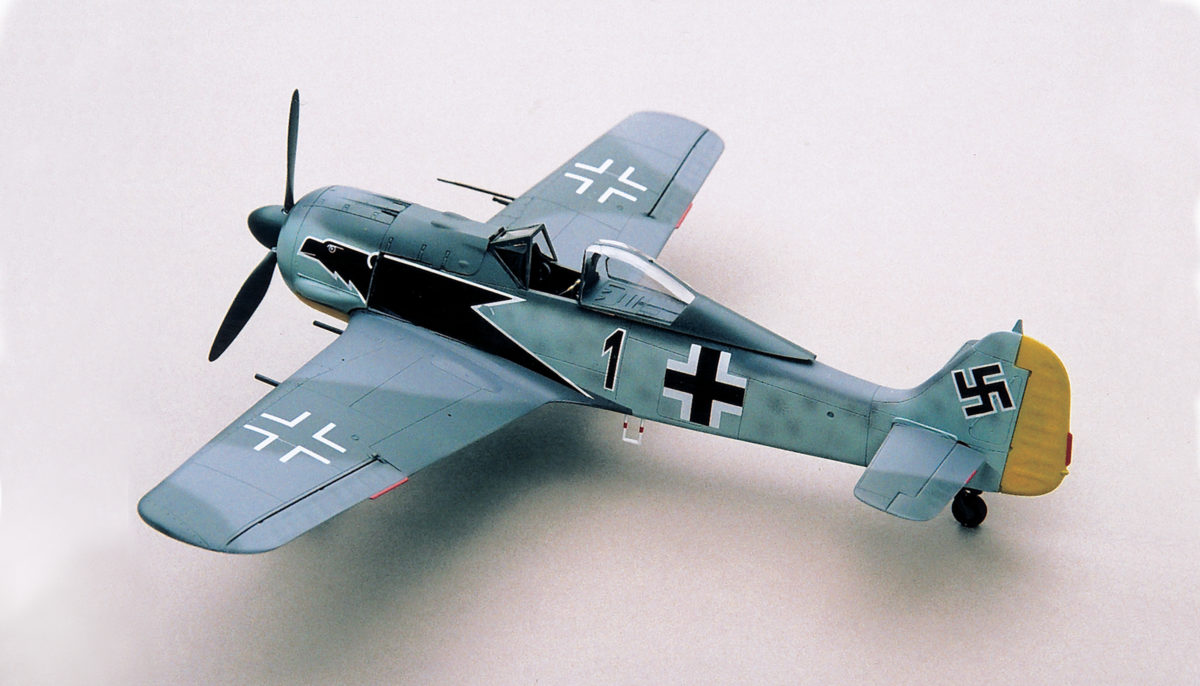In the early fall of 1941 pilots reported the first appearance of a new German fighter accompanying formations of Messerschmitt Me-109s over northern Europe. That fighter, which eventually became known as the Focke Wulf Fw-190, was the result of a Luftwaffe Reichluftfahrtministerium (RLM) project headed by the noted German weapons designer Kurt Tank.
As 1941 wore on, more and more Spitfires began to fall due to the significant firepower and speed of this new aircraft. One man who flew the Fw-190 to acclaim was 1st Lt. Horst Hannig. Hannig’s personal mount was an A-4 variant of the 190, this month’s project.
The 1/48th scale kit by Tamiya is an A-3 variant, easily converted to an A-4 with a simple modification. Construction starts with the assembly of the seven-part cockpit. German World War II cockpits were generally painted grau, RLM-02. To add depth to an otherwise dull interior, paint the instrument panel and side consoles schwarzgrau, RLM-66. A few dots of silver, red and yellow provide the details needed to add interest to the “front office.” Cut thin paper strips, painted schwarzgrun, RLM-70, for the seat harness.
While the cockpit parts are drying, paint the sidewalls of the fuselage RLM-02 and then cement the two sections together. The BMW-801D-2 14-cylinder radial engine looks good painted “gunmetal” with a drybrushing of silver to set off the details. The instructions call for the engine to be attached to the fuselage at this point, but hold off on this step for now.
The Fw-190A-4 that Oberleutnant Hannig flew was externally identical to the A-3 version—with one exception. The A-4 had the new FuG-16 radio installed, which required a small blade antenna to be positioned on the tip of the vertical tail. Carefully sand off the antenna wire attachment point on the top of the kit’s vertical stabilizer and replace it with a small triangular blade antenna cut from .015 plastic strip from Evergreen Scale Models. A close-to-scale drawing of the antenna’s shape can be found on P. 20 of the Squadron/Signal Publication FW-190 in Action.
With the new antenna attached, turn the fuselage upside down and cement the cockpit into place. The engine can also be attached at this time. The fuselage subassembly should be set aside to dry.
Next glue the main wheel well interior into the bottom wing section and secure the wing top pieces. Be careful not to break off any of the four protruding 20mm FF cannons during this phase of construction. (I did and had to replace it with a 1⁄2mm length of .062 plastic rod.)
The wing assembly and horizontal stabilizers should now be fixed in place. The basic construction of the aircraft is now complete, and it’s time to check out any flaws in your work. The fit of the wing to lower fuselage joint probably needs a tiny bit of filler and sanding. A coat of a light gray primer will show up any other areas that might need additional attention.
Debates among modelers have raged for years over the exact color of the undersides of German WWII aircraft. It is generally agreed that the color is lichtblau, RLM-76, and NOT hellblau, RLM-78, as indicated on the instruction sheet. This color should be painted on the underside, a large portion of the fuselage sides and the vertical tail. The top of the wings and fuselage is a “soft” camouflage pattern of graugrun, RLM-74, and grauviolett, RLM-75. There are also random splotches of these colors on the fuselage and vertical tail. The underside of the cowling and the rudder of Hannig’s aircraft were gelb, RLM-27. (All of the German camouflage colors, with corresponding RLM numbers, can be found in the Model Master paint line at local hobby stores.)
Hannig was the commander of the 2nd Staffel, Jagdgeschwader 2, which was based near Cherbourg, France, during part of 1943. A photo and a color drawing of his aircraft can be found on the Web site www.elknet. pl/acestory/hannig/hannig.htm.
The distinctive Richthofen black eagle along with the other markings for Hannig’s 190 can all be taken from the kit’s decals except for the fuselage side insignia. These Balkenkreuz come from the Third Group decal sheet, #48-037.
Our model shows Hannig’s plane as it reportedly appeared on the afternoon of May 15, 1943, before he was shot down by a British Spitfire Mk. IX from 611 Squadron at Biggin Hill. The downing of Hannig was Biggin Hill Wing’s 1,000th victory.
Originally published in the March 2006 issue of Aviation History. To subscribe, click here.





